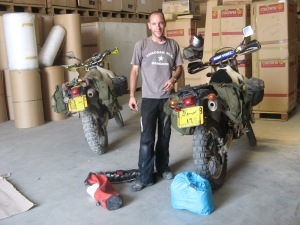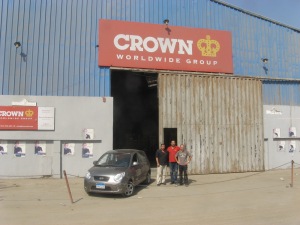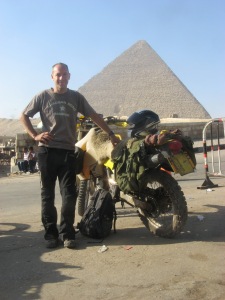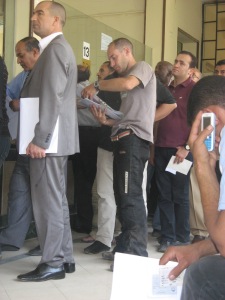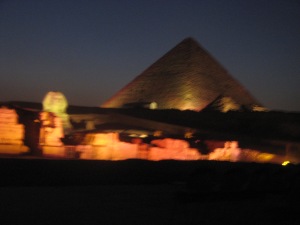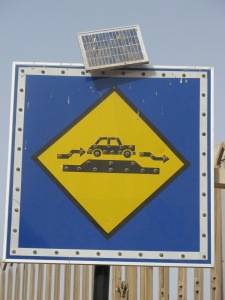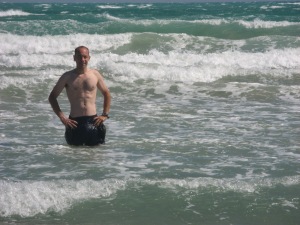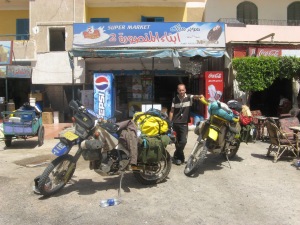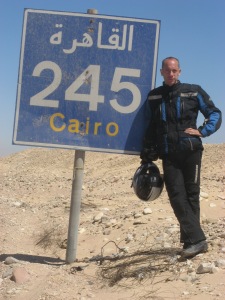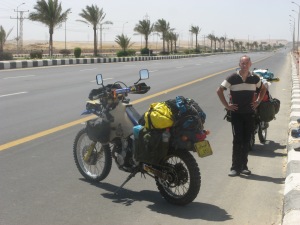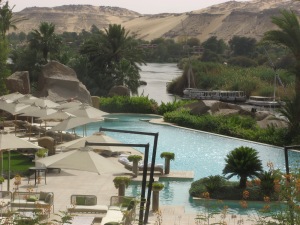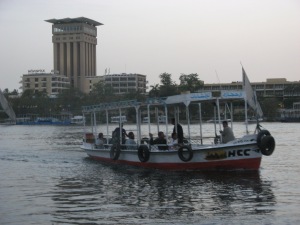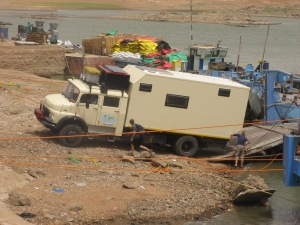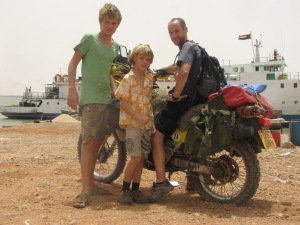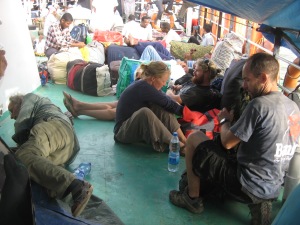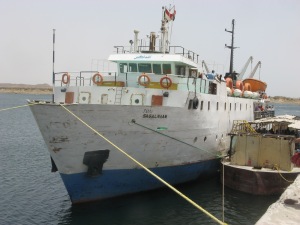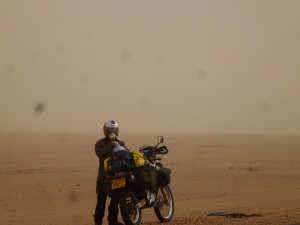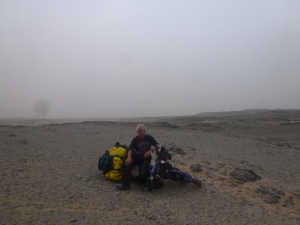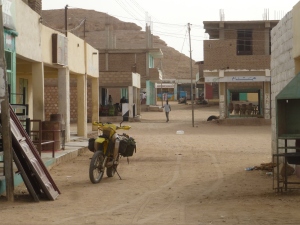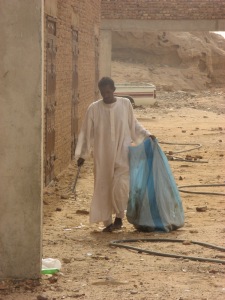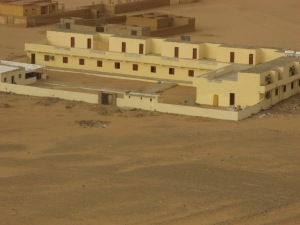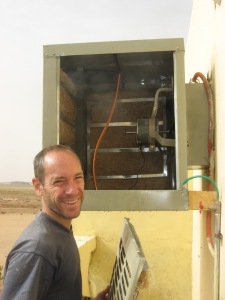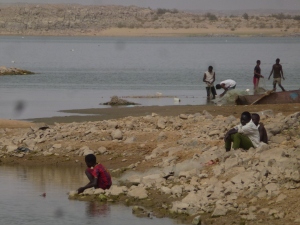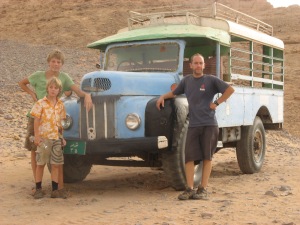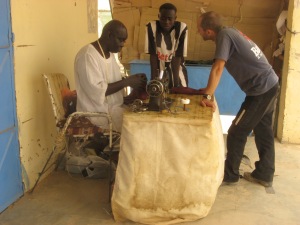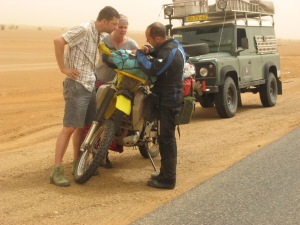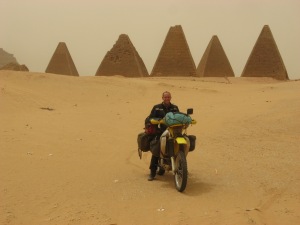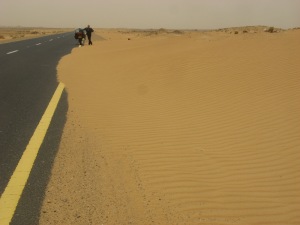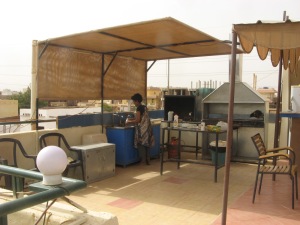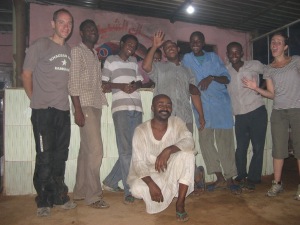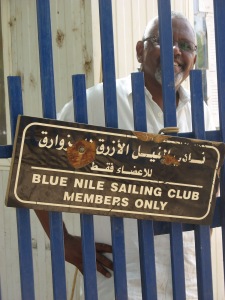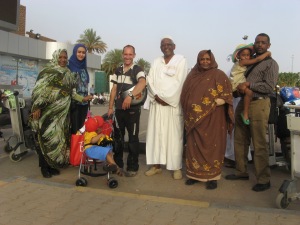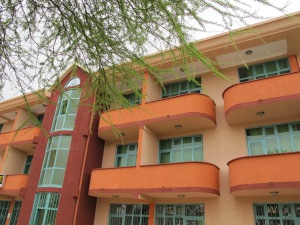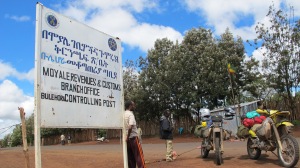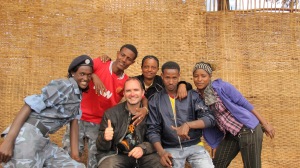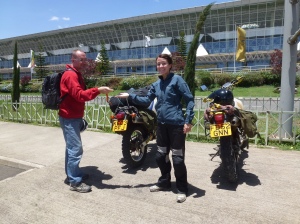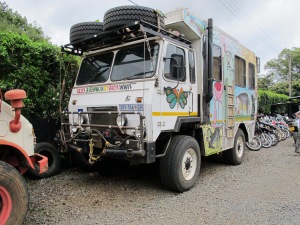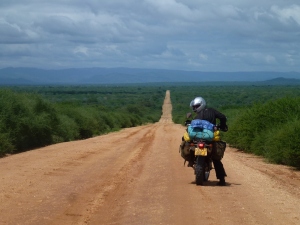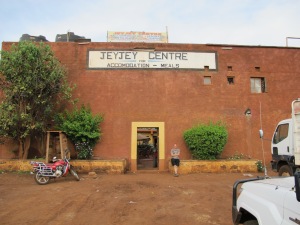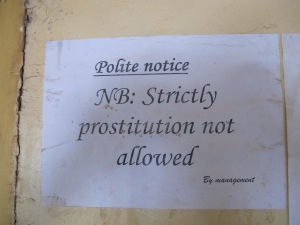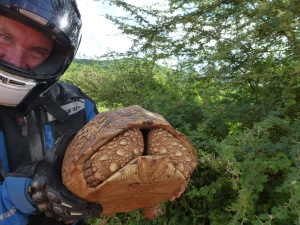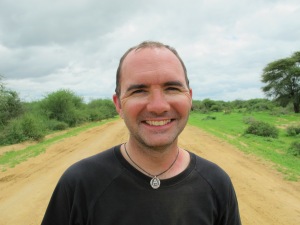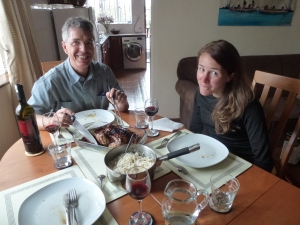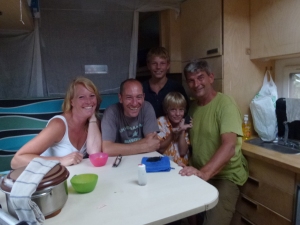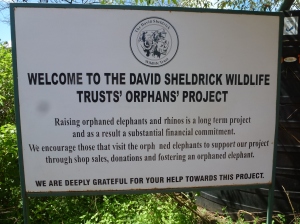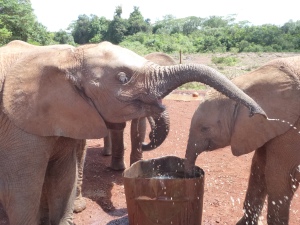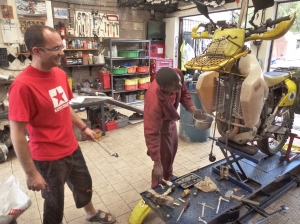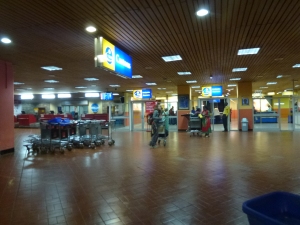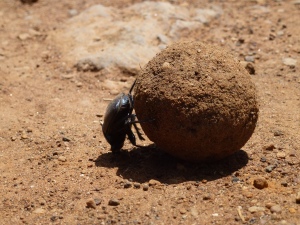Friday and tomorrow we have to catch the plane home; it was time to deliver the bikes to the freight forwarding company, pack our gear, catch that taxi to the airport and leave Africa. Kristian had to be in the office for work on Monday – his three months ‘sabbatical’ completed. We had long given up on the option of riding the bikes back to London. That particular option had faded with the internal wars that erupted, respectively, in Libya and Syria – effectively blocking our route. A choice of Libya would have been reasonable, and with the opportunity of leaving the bikes in Rome for a leisurely ride across Europe later in the year. And, in reality, we met people going south in Aswan who had ventured across both countries during the past few weeks – but we were by then committed to freighting the bikes and flying.
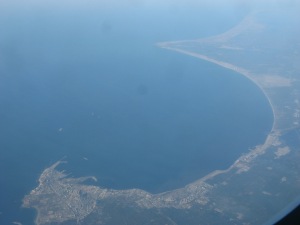
Last views of Africa – Egypt on the Mediterranean. Alexandria to the west of Abu Qir and just in the picture – 200 km from Cairo and climbing. Four hours to go to LHR and the realization that the ride had actually finished. Back to normality from next week on then
Getting ready to send the bikes home
Cairo we already knew, but not from the seat of a motorbike. Like traffic patterns everywhere, however, you quickly get to read the road and adapt to local practices. Traffic is furious, but relatively benign (and not as difficult as it first seemed – it’s much more difficult to cross the road on foot in places). Fortunate with the GPS unit on the yellow bike – we could GPS ourselves just about anywhere quickly; and take those many short cuts round the back of difficult traffic that only the locals knew about. Enduro bikes can handle all kinds of Cairo back roads. Where you do have to take note, however, is that sheen of sand that covers just about everything including the road surfaces. Skidding is easy on good tarmac surfaces. Skid one way, over-correct and then skid the other with an over-enthusiastic rear brake and – waiting to come off the bike but just saving yourself in time – and you quickly learn to appreciate space, timing and judicious use of brakes in the traffic flow. Come off and they’d run over you – speeds on the main ring roads were high – and people would probably not be able to re-act quick enough to miss you.
The freight agents had their main office in Maadi to the south of the city – but we couldn’t find low cost accommodation there; we looked and failed – eventually staying at a camping/motel place just a few minutes ride from the El Giza Pyramids to the SW of the city. It was the third camping place we tried. And, as it turned out, this was also where the company had their Cairo warehouse – where we eventually delivered the bikes for shipping back to the UK. But we didn’t know that until later.
Stop in Cairo, and there was that sense of loss from daily routines without a couple of bikes on hand – with shift in dependency upon others for transport. And, too, there was the added constraint of all that gear that we had to shift – 70 kg in total. And we know this because this is the extent of the check-in luggage allowance that we had on our respective Egyptair and British Midlands flights to London. We checked it out before packing.
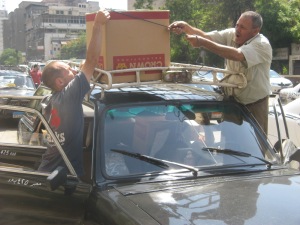
Taxi driver Sayed & Kristian loading up his 40 year old P405 taxi before leaving for Cairo Airport. New city taxis are unlikely to deliver an ELV, however, given the high value of road vehicles in Egypt; they’ll simply be shifted into the country or smaller towns.
Taxi to the airport
In the two years since I’d last worked in the city, the taxi fleet has seriously begun to change – out have gone (or are going) the majority of those 40 year old black and white Renaults, Peugeots and Fiats that used to clog up the roads with their crumpled bodywork, smoky exhausts and noisy clatter (and in which none of the interior door handles or fittings worked either). They were always a challenge when it came to deciding prices/fares – you had to agree before getting in, which is difficult for newcomers (meaning mainly foreigners) who tend to bring with them their sense of fair-play, reasonableness and gullibility. Again, you quickly learned with this one (taking a guide on prices from locals). The Koreans had been here in the interim, and brand new brilliant white Hyundai’s had become king of the road in Cairo – with air/con, comfort and meters that actually worked.
But we couldn’t resist phoning Sayed my irregular, but long-time, driver to see if he and his venerable Peugeot 504 station wagon were still around – and they were! On-and-off for a couple of years, Sayed had run me (and sometimes Ivy too when she was staying over) to the tourist sites north and south of the city at the weekends, and waited patiently as we trooped through pyramid fields, fortified monasteries or rural museums. For the longer distances at the weekends – coaches and/or trains were a better deal, but up to 50 km out-of-town you can’t beat a friendly taxi man. He’d meet me at the airport at the beginning of a contract and, a few weeks later – work completed – he would drop me back again.
He worked the entrance to the Victoria Hotel and, for me, was one of a small group of hotel people – waiters, cleaners, receptionist and the barber – who always made you feel like a long-lost son returning home. He was pleased to catch up (for, of course, he’d no idea of our coming into Cairo on a couple of bikes. Kristian he’d never met).

Victoria Hotel Central Cairo – where we had tried to book rooms, but failed. The deal offered did not come within our budget.
The good thing about these old Africa cars is the space that they offer when compared to the new alternatives. And what we couldn’t get inside for our ride to the airport, we stacked on the roof. And, his car never broke down – it wheezed, groaned and lurched over the roads, but always went. Grow up in Africa during the past 30-40 years – before the Toyota invasion – and you always remember the suspension and the seats of Peugeot cars. (The rest can be pretty average – particularly the metalwork – but comfort was never an issue on even the roughest roads.) And you could also fix them easily when needed.
Like the Peugeot 504 that he’d driven for close on 30 years, Sayed is unlikely to survive the Hyundai invasion, and we’re not sure when we’ll get back to see him again. He was part of the Victoria Hotel team – working the tourist traffic. (Look the hotel up in Lonely Planet – Olde Worlde, 1920s decor, large dark and cool rooms, and an Agatha Christie feel about it – you could almost see Poirot coming out of the lounge.) It’s near to the main-line station in Ramsis Square, where I had stayed on-and-off for a couple of years – and I liked the people, style, architecture and value of the place; only we couldn’t afford it this time round.
Management offered a discount but it simply wasn’t sufficient, so we stayed round the corner in their more modern but bland sister hotel. But it was good to walk around the Victoria saying ‘hello’ to everyone again. I’d had a haircut in Aswan, and couldn’t take advantage of my friend the hairdresser in the Victoria – famous for having tinted my hair yellow on one visit. Imagine; he said he was doing me a favour. The family thought it had been the sun and/or the pollution in the city on that particular mission.

With only Shaun missing from the team of riders there are L-R: Peter, Anna & Kristian. Anna had left in Khartoum and was part of the ‘Meet&Greet’ party at LHR.
Journey’s end
The journey ended where it began – at London’s Heathrow Airport; we’d departed Cairo with 15 minutes between flights – Kristian leaving first – and expecting to arrive within 30 minutes of each other. The earlier BMI flight, however, was delayed – but we didn’t know that at the time. The meet and greet family group at Terminal 3 were as welcoming as ever, but where was Kristian? I had seen the flight number on the carousel, and hung around looking for him. As it turned out, there were two BMI flights incoming from Cairo at the same time and with similar codes that evening, and the second had been routed to Terminal 1. So, more last minute rushing around. Lost at LHR without our SAVNAT – it was a fitting end to a challenging three months of riding Africa on two wheels.
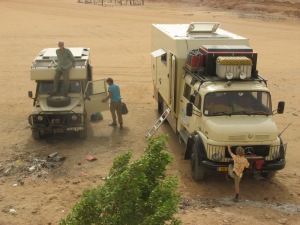
Road companions for >3,000 km that’s Geof Henman on the bonnet of his LR camper, and Vincent Arkesteijn footing between the two vehicles – with young Sjors climbing on to the bumper of the MB. The truck had spent most of its life as a fire tender in Belgium before sale and conversion.
And about those fellow travellers?
The Arkesteijn Family – whom we had travelled with on-and-off since Nairobi and had left behind in Aswan – eventually took the ferry to Jordan, crossed into Israel and caught the ferry to Italy. We had last exchanged an SMS with them from a beach in Haifa. They were due into northern Italy and would not be coming through Rome.
Geof Henmen and his battered Land Rover camper eventually made it home too. His vehicle had travelled on a ‘wish and a prayer’ since Khartoum and, for the best part of the ride to Wadi Halfa, it had been driven by Ilse Arkesteijn – helping out when Goef had become too ill to drive. Goef was met in Aswan by his wife Ann who’d flown in from the UK to assist him – and they’d figured on the best way to get ‘man and machine’ back home. In the event, it was transported to Alexandria on the back of a flat-deck truck for a highly reasonable £250, and then shipped back. Adventure completed.
And about those bikes

Focus upon the blue bike in case you’ve not noticed it before. Ten years old with around 30,000 miles, bash plates, over-sized tank and renewal of peripherals before the journey, it has stood up well to the mixed handling of three different riders. If you want a recommendation for riding Africa – consider the cost-effectiveness, simplicity and handling ease of this design. It comes highly recommended.
And the reality of R&M? A carburettor seal in Windhoek; a couple of oil changes – Lusaka & Nairobi; tyres, headstock steering bearings and a clutch cable in Nairobi and – a perennial issue with both bikes – dust, vibration and connections in the wiring looms – that resulted in poor charging, refusal to start and similar issues. We had spent the last couple of days in Cairo bump starting the yellow bike – it simply would not charge sufficient to rotate the engine fast enough on the starter. Next time? Fit a kick start.
The bikes were not particularly comfortable for long-distance travel – and better suited smaller riders. Sure we’d choose them again – they proved themselves and there is this thing about knowing your bike.
We had bought the bikes on eBay, and this is where they will eventually be sold; that is unless there are any enthusiastic readers out there looking to make a Cairo to Cape Town journey next winter.
London
10 June 2012

